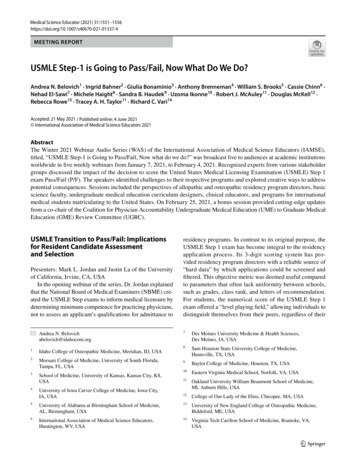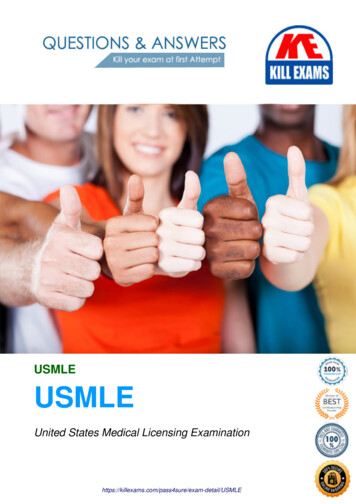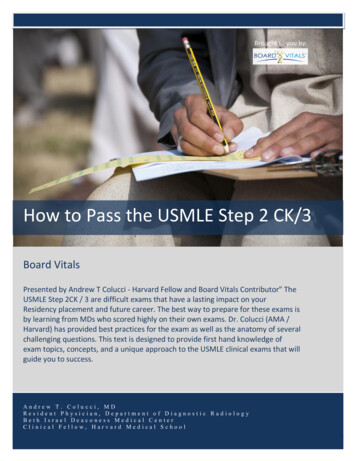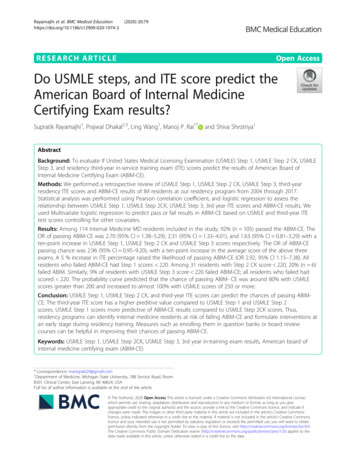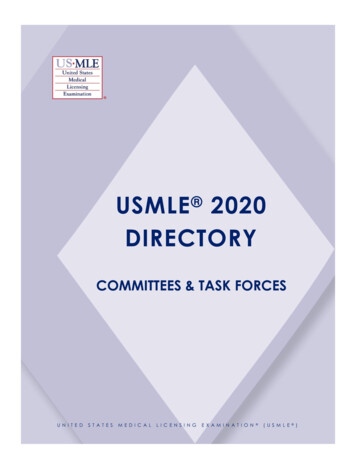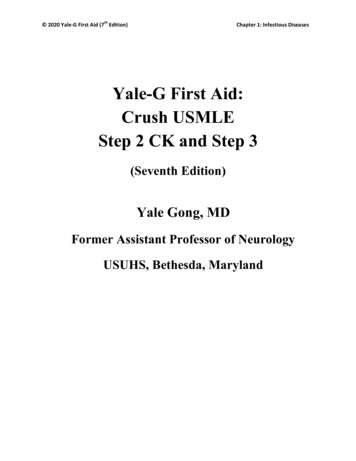
Transcription
https://www.pass4itsure.com/usmle-step-2.html2022 Latest pass4itsure USMLE-STEP-2 PDF and VCE dumps DownloadUSMLE-STEP-2Q&AsUnited States Medical Licensing Step 2Pass USMLE USMLE-STEP-2 Exam with 100%GuaranteeFree Download Real Questions & Answers PDF and VCE file 100% Passing Guarantee100% Money Back AssuranceFollowing Questions and Answers are all new published by USMLEOfficial Exam CenterLatest USMLE-STEP-2 Dumps USMLE-STEP-2 PDF Dumps USMLE-STEP-2 Exam Questions1/6
https://www.pass4itsure.com/usmle-step-2.html2022 Latest pass4itsure USMLE-STEP-2 PDF and VCE dumps DownloadQUESTION 1A young mother claims that her 4-week-old child sleeps best on his stomach. You tell her that the safest sleep positionfor infants is which of the following?A. on the backB. on the stomachC. on the sideD. on the back with the head elevated by a pillowE. in the parents\\' bedCorrect Answer: AProne sleeping is a major risk factor for sudden infant death syndrome (SIDS). Since the 1992 American Academy ofPediatrics (AAP) recommendation that infants be placed to sleep on their backs, the frequency of prone sleeping hasdecreased from 70 to 20%, and the SIDS rate has decreased by 40%. Side sleeping has a slightly higher SIDS riskthan supine but is still safer than the prone position. Other risk factors include maternal smoking, soft bedding,overheating, younger maternal age, prematurity, low birth weight, and male gender. Rates among African Americansand Native Americans are two to three times the national average. The issue of bed sharing or cosleeping iscontroversial. There are reports of overlying by adults leading to suffocation, especially when the adult uses drugs oralcohol. Bed sharing with multiple family members may be hazardous; there is increased risk of overlying, entrapment,rolling into prone position, and use of soft sleeping surfaces. Some studies show that infants have more arousals andless slow-wave sleep during bed sharing; however, there is no epidemiologic evidence that bed sharing is protective.QUESTION 2A 12-year-old girl has had a sore throat over 2 days. She now has a fever of 39.5 C and has difficulty opening hermouth, swallowing, or speaking. Her throat can be visualized with difficulty, the right tonsil is significantly more enlargedthan the left, and the uvula is displaced to the left side. Which of the following is the most likely diagnosis?A. retropharyngeal abscessB. acute uvulitisC. peritonsillar abscessD. acute pharyngitisE. lateral pharyngeal abscessCorrect Answer: CThis is a classic presentation for a peritonsillar abscess. Development of a peritonsillar abscess is usually preceded byacute pharyngotonsillitis, followed by development of severe throat pain and trismus. It is usually caused by group Ahemolytic Streptococci or oral anaerobes in preadolescent or adolescent patients. Speech is often with a "hot potato"voice. The affected tonsil is enlarged causing the uvula to be pushed to the other side. Antibiotics (penicillin) andincision and drainage are usually required. Retropharyngeal abscess is usually a complication of bacterial pharyngitis inyounger children under age 34 years. It is caused by infection and further suppuration of nodes in the retropharyngealarea. Symptoms include high fever, difficulty swallowing, feeding refusal, hyperextension of the head, and drooling.Latest USMLE-STEP-2 Dumps USMLE-STEP-2 PDF Dumps USMLE-STEP-2 Exam Questions2/6
https://www.pass4itsure.com/usmle-step-2.html2022 Latest pass4itsure USMLE-STEP-2 PDF and VCE dumps DownloadThere is bulging of the posterior pharyngeal wall; diagnosis can be confirmed by widening of the retropharyngeal spaceon x-ray. With lateral pharyngeal abscess there is bulging of the lateral pharyngeal wall. Acute uvulitis is caused bygroup Ahemolytic Streptococci and H. influenzae type B, often in association with tonsillitis and uvulitis.QUESTION 3A 5-week-old infant presents with a 1-week history of progressive nonbilious emesis, associated with a 24- hour historyof decreased urine output. The infant continues to be active and eager to feed. On examination, the infant has a sunkenfontanelle and decreased skin turgor. The abdomen is scaphoid, and with a test feed, there is a visible peristaltic wavein the epigastrium. The diagnosis is best confirmed by which of the following?A. abdominal ultrasoundB. careful clinical examination with palpation of an epigastric massC. UGI contrast studyD. surgical explorationE. endoscopyCorrect Answer: BInfants with pyloric stenosis usually present after the third week of life with symptoms of progressive pyloric outletobstruction secondary to increasing hypertrophy of the pyloric muscle. There are often clinical signs of dehydration, butthe infant usually appears well and is eager to feed. Viral gastroenteritis and urinary tract sepsis may be associated withsigns of such systemic illness as lethargy, poor feeding, and, in some cases, fever. Gastroesophageal reflux moretypically presents with a history of regurgitation since birth. Milk protein allergy is often associated with colickyabdominal pain and diarrhea. The pathognomonic sign on clinical examination is a palpable "olive" in the epigastrium orright upper quadrant. Abdominal ultrasound is operator dependent, but with expertise in interpretation of the study, thethickened elongated pyloric channel can be demonstrated. AUGI contrast study may show the classic "shouldering" ofthe pyloric muscle, with a "string sign"; this also requires expertise in performing the examination, and other causes ofpyloric outlet obstruction, such as pylorospasm may be misinterpreted as a positive study. Surgical exploration shouldbe reserved for those patients in whom the diagnosis has been confirmed and only after the infant has received fluidresuscitation. Infants with gastric outlet obstruction develop a hypochloremic, hypokalemic metabolic alkalosis. This issecondary to the loss of chloride in the gastric contents, and the renal reabsorption of sodium in exchange for potassiumand hydrogen. Carbonic anhydrase converts carbonic acid to hydrogen and bicarbonate ions, allowing hydrogen to beexcreted in the urine, with retention of the bicarbonate. Hence, with the metabolic alkalosis, there is a "paradoxicalaciduria." Hypernatremic, hyperchloremic, hypokalemic metabolic acidosis develops in infants with diarrhea. Infants withgastroesophageal reflux do not usually develop significant electrolyte derangements. Infants with pyloric stenosis willusually require a period offluid resuscitation to correct hypovolemia as well as electrolyte and acid-base abnormalities.This is followed by a pyloromyotomy. Infants with vomiting and diarrhea from viral gastroenteritis are often successfullymanaged with oral rehydration. Prokinetic agents have been used in the management of gastroesophageal reflux. Soyformulas or elemental formulas are recommended for the infant with a milk protein allergyQUESTION 4A 28-year-old man has the acute onset of colicky pain in the left costovertebral angle radiating into the groin, as well asgross hematuria. Abdominal x-ray discloses a stone in the left ureter. Which of the following is true concerning thisdisease?A. The majority of renal stones are radiolucent.Latest USMLE-STEP-2 Dumps USMLE-STEP-2 PDF Dumps USMLE-STEP-2 Exam Questions3/6
https://www.pass4itsure.com/usmle-step-2.html2022 Latest pass4itsure USMLE-STEP-2 PDF and VCE dumps DownloadB. Radiolucent stones are usually composed of uric acid.C. Staghorn calculi are associated with acid urine.D. Radiopaque stones usually contain cystine.E. Urate stones are associated with alkaline urine.Correct Answer: BMore than 90% of renal stones are visible on a plain abdominal x-ray, and the majority contain calcium oxalate.Staghorn calculi usually contain magnesium ammonium phosphate (triple phosphate or struvite) and are associated withalkaline urine. This is commonly encountered in chronic urinary tract infections with urea-splitting bacteria. Radiolucentstones often contain urea, which is associated with acidic urine. A small percentage (fewer than 10%) of renal stonescontain cystine. The most common cause of calcium stone disease is idiopathic hypercalciuria. Almost half thesepatients will excrete more than 4 mg of calcium/kg body weight/24 h in the absence of hypercalcemia. Causes ofhypercalciuria to be ruled out are sarcoidosis, hyperparathyroidism, and Paget\\'s disease of bone. Idiopathichypercalciuria is believed to result from either increased GI absorption of calcium, increased calcium resorption frombone, or excessive renal calcium leakage into the urine.QUESTION 5A 32-year-old, previously healthy man is a victim of a drive-by shooting, sustaining a gunshot wound to the left lowerextremity. The entrance wound is located over the medial aspect of the calf, with an exit wound over the anteriorpretibialregion. Neurovascular examination of the extremity is normal. There is associated soft-tissue injury from the blast effectand a severely comminuted tibial fracture demonstrated on radiographs.Appropriate management of this injury includes which of the following?A. local wound irrigation, closure of the soft-tissue defect, closed reduction, and immobilization in a long- leg castB. local wound irrigation with antibiotic solution, closed reduction, and immobilization in a long-leg cast, with continuedlocal wound care through an anterior cast windowC. tetanus prophylaxis, intravenous (IV) antibiotics, and operative wound irrigation and debridement, with application ofan external fixation deviceD. tetanus prophylaxis, IV antibiotics, operative wound irrigation with closure of the soft-tissue defect, closed reduction,and immobilization in a long-leg castE. tetanus prophylaxis, IV antibiotics, longleg splint for immobilization, and operative intervention during elective surgicalscheduleCorrect Answer: CThis is an open fracture, and management constitutes an orthopedic emergency. Tetanus prophylaxis is indicatedbecause the softtissue injury is a tetanus-prone wound. An open fracture is associated with a high risk of osteomyelitis.Systemic antibiotics should be started in the emergency department and continued postoperatively. Optimal local woundirrigation and debridement is achieved under general anesthesia. This fracture is severely comminuted and most likelyunstable. Fracture stabilization can be accomplished with internal fixation or application of an external fixation device.The soft-tissue defect associated with an open fractureLatest USMLE-STEP-2 Dumps USMLE-STEP-2 PDF Dumps USMLE-STEP-2 Exam Questions4/6
https://www.pass4itsure.com/usmle-step-2.html2022 Latest pass4itsure USMLE-STEP-2 PDF and VCE dumps Downloadshould not be closed primarily. It may require further debridement. With aggressive local wound care, delayed closuremay be possible if the wound remains clean. Local wound irrigation and debridement may be limited by patientdiscomfort.The addition of antibiotics to the irrigation solution is of no additional benefit. Closed reduction would not be possible inthis patient because the fracture is severely comminuted. Furthermore, a longleg cast will not provide adequateimmobilization of the unstable fracture fragments.Latest USMLE-STEP-2DumpsUSMLE-STEP-2 PDFDumpsUSMLE-STEP-2 ExamQuestionsLatest USMLE-STEP-2 Dumps USMLE-STEP-2 PDF Dumps USMLE-STEP-2 Exam Questions5/6
https://www.pass4itsure.com/usmle-step-2.html2022 Latest pass4itsure USMLE-STEP-2 PDF and VCE dumps DownloadTo Read the Whole Q&As, please purchase the Complete Version from Our website.Try our product !100% Guaranteed Success100% Money Back Guarantee365 Days Free UpdateInstant Download After Purchase24x7 Customer SupportAverage 99.9% Success RateMore than 800,000 Satisfied Customers WorldwideMulti-Platform capabilities - Windows, Mac, Android, iPhone, iPod, iPad, KindleWe provide exam PDF and VCE of Cisco, Microsoft, IBM, CompTIA, Oracle and other IT Certifications.You can view Vendor list of All Certification Exams d HelpPlease provide as much detail as possible so we can best assist you.To update a previously submitted ticket:Any charges made through this site will appear as Global Simulators Limited.All trademarks are the property of their respective owners.Copyright pass4itsure, All Rights Reserved.Latest USMLE-STEP-2 Dumps USMLE-STEP-2 PDF Dumps USMLE-STEP-2 Exam QuestionsPowered by TCPDF (www.tcpdf.org)6/6
2022 Latest pass4itsure USMLE-STEP-2 PDF and VCE dumps Download should not be closed primarily. It may require further debridement. With aggressive local wound care, delayed closure may be possible if the wound remains clean. Local wound irrigation and debridement may be limited by patient


